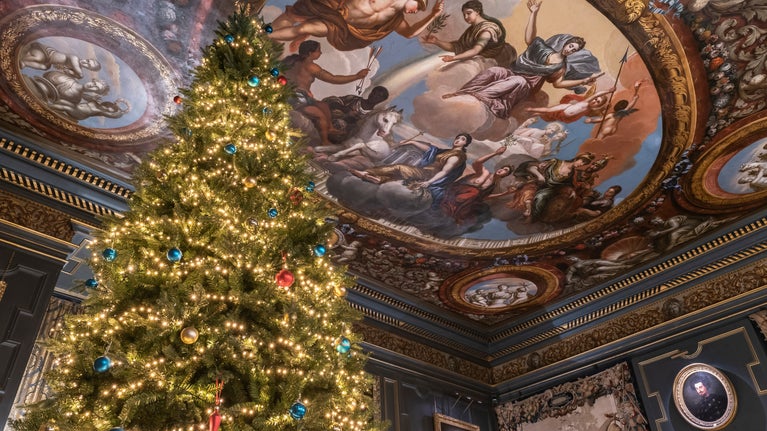
Immerse yourself in history
Meet people from the centuries gone by, learn about the unique artworks in our care and understand more about historic traditions.


The first day of May is a time to glory in the vitality of spring. Delve into the May traditions that have brought communities together throughout history, and see the objects from our collections that relate to this ancient festival.
May festivities were first recorded in Ancient Roman times. The Floralia – the Festival of Flora – took place between 28 April and 3 May in honour of the goddess of flowers, fertility and spring. It involved athletic games and theatrical performances.
Later depictions of these events have an elegant air but in the ancient world they were notorious for lewd and chaotic behaviour. Vegetables were pelted and wild hares and deer were released into the crowds as symbols of fecundity.
In Roman mythology, Flora is the goddess of flowers and spring. The Austrian artist Johan Georg Platzer’s oil painting, from the collection at Basildon Park in Berkshire, captures the fertile energy of the feast.
In the Gaelic world, the opening of the summer pastures for grazing was marked by the Beltane festival. Wild blossoms decorated the doors and windows of houses while great bonfires were built on the last night of April to bestow their protective powers on livestock and their herders.
First recorded in the early medieval period, these rural traditions had come to an end by the middle of the 20th century but have since been revived as an evocation of even older Druidic rites. In Wales, where the first day of May is known as the Calan Mai or Calan Haf, these customs never died out.
This began to emerge as a day of feasting and dancing in towns and villages across the British Isles from the medieval period. A host of exuberant traditions developed to mark the day, now mostly forgotten.
Chimney sweeps wearing gaudy clothes would make mischief on the street and hustle for coins. Milkmaids would dance for pennies while balancing towers of borrowed silverware on their heads.

A beribboned May Day reveller receives a coin in this anonymous 19th-century painting at Wimpole Hall, Cambridgeshire. Maypole dancers can be seen in the background.
See the painting in our collection
Like many other festivals, May Day was a topsy-turvy affair when a ‘lord and lady’ would be chosen from among the ordinary people of the community to preside over the day. Eventually the focus shifted completely onto the woman and she became known as the May Queen.
This figure reached the height of her importance in the late Victorian and Edwardian periods, by which time she was embodied by a young girl decorously dressed in white and crowned with flowers. Accompanied by a ‘court’ of other girls, the May Queen had become a symbol of purity and the promise of spring.
The quintessential image of May Day is of dancers weaving the long ribbons of a maypole into intricate patterns. This practice was first recorded in mid-14th-century Wales but eventually spread far and wide.
As time went by, it evolved from an opportunity to flirt into a picturesque pastime for children, often tinged with nostalgia for a simpler and more innocent way of life.
May Day has not always been welcomed as a festival of harmless fun. Unrelated to the Christian calendar and all too reminiscent of pagan fertility ritual, attempts were sometimes made to suppress its revels.
The most comprehensive campaign against May Day was waged during Oliver Cromwell’s Commonwealth. Upon the restoration of the monarchy in 1660, maypoles were raised across the land as a gleeful marker of the end of Puritan prohibitions.
The May Day Bank Holiday was instituted by Michael Foot, then the Labour Employment Secretary, in 1978. A latter-day controversy flared up when it became a bone of contention for those who objected to the socialist connotations of the date.
Back in 1891, the first day of May had been designated International Workers’ Day and set aside for organised industrial agitation: the energies of the spring festival turned to political ends.
In more recent times, visitors to the places in our care have celebrated May Day in old ways and new. Local primary school children have performed maypole dances across the country, from Wallington Hall in Northumbria, to Quarry Bank Mill in Cheshire, to Stowe Gardens in Buckinghamshire.
Elsewhere, the long weekend has become a chance for families to explore many layers of history. Corfe Castle in Dorset – long the site of May Day dances – now hosts re-enactments of Viking and Saxon conflict.
In 2019 at Stourhead in Wiltshire, the May festival came full circle. Among the classically inspired temples and statues, the Festival of Flora was celebrated once more with a day of activities. Garlands of daisies were constructed to the ancient cry: ‘Io Floralia!’

Meet people from the centuries gone by, learn about the unique artworks in our care and understand more about historic traditions.
Learn the ancient origins, traditions and folklore of the summer solstice and discover how midsummer was celebrated in millennia past at some of the places we care for.

From silver charms in Christmas puddings to early Advent calendars, learn more about the ways our Roman, Victorian and medieval ancestors prepared for the festive season.

See the breadth of our collection of works of art, furniture and more: we care for around a million objects at over 200 historic places, there’s a surprise discovery around every corner.
